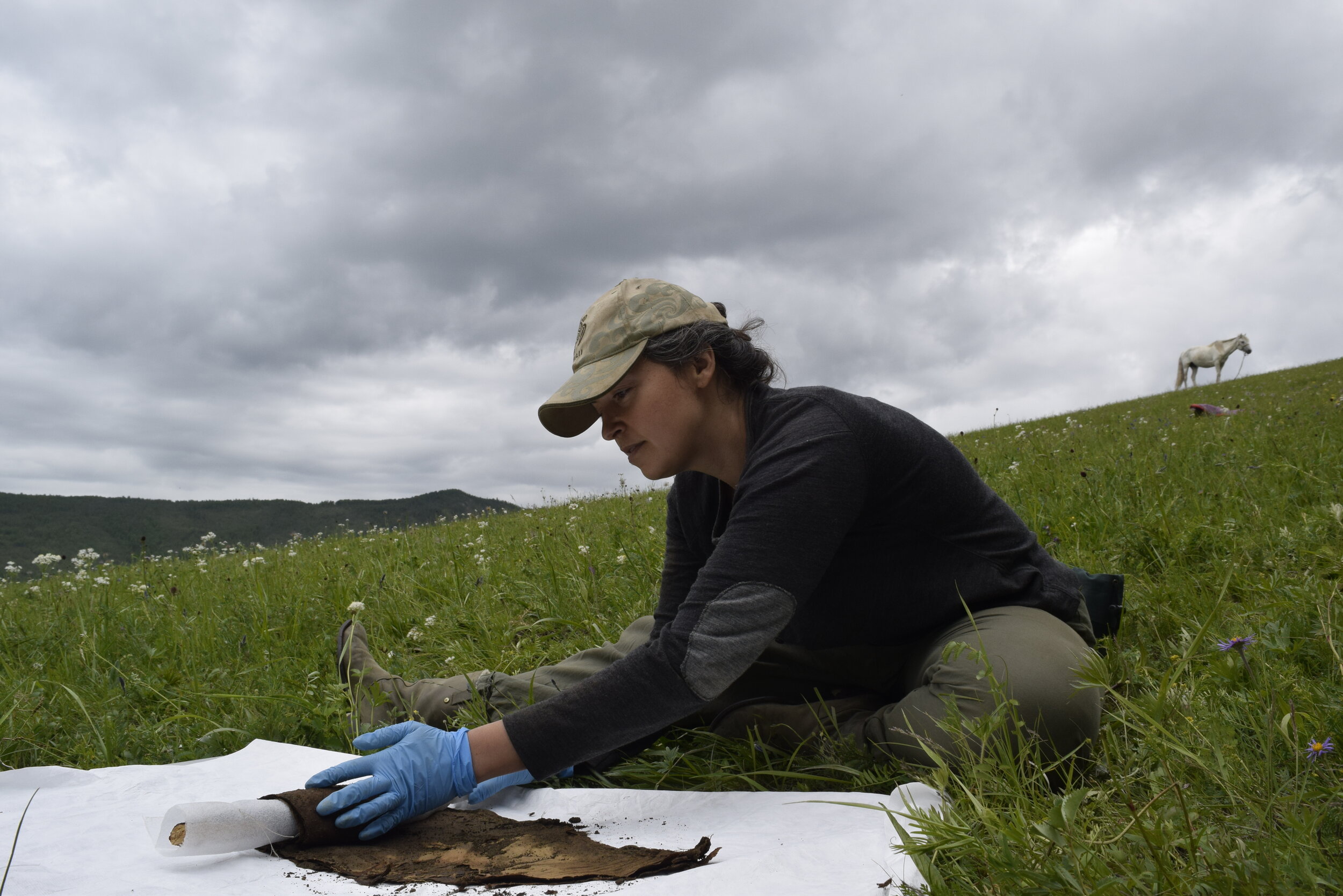Session I: Salvage Archaeology, Bioarchaeology and Field Conservation
A conservator recovers an extremely fragile golden stamped and threaded textile from one of the looted graves
A ceramic vessel that had been frozen in the permafrost is recovered from one of the looted burials and amazingly contains well preserved 800 year old butter
Dates: June 22- July 18, 2025
Fee: $3,550 USD
APPLICATION now closed. Check back next year!
Applications accepted on a rolling basis until April 1st or until the program is full.
Skills: archaeological excavation and survey; basic artifact cataloging and conservation; artifact conservation, and bioarchaeological analysis
Logistics: We will camp near several known looted cemeteries, but may travel from time to time to survey and monitor areas farther afield. The remaining cemeteries are located on the tops of steep hills with little or no vehicle access, and so students should be able to do some hiking. Participants should bring their own tent and camping equipment. Water may be purified from nearby rivers and lakes. Project cooks will prepare all meals.
Description: The illegal looting of ancient burial sites has become a big problem in Northern Mongolia. During the summers of 2017-2024, the NOMAD Science team witnessed 100’s of instances of new looting, including the complete destruction of cemeteries from the Bronze Age through the Medieval Mongol Era- bits of metal and wood artifacts, human bones, and clothing fragments were strewn on the surface and would not survive long without our intervention. Thieves get away with priceless cultural heritage objects that will likely never be recovered, while completely disrespecting the final resting places of ancient people. Archaeologists are concerned because looting permanently destroys our ability to continue answering research questions for the benefit of humankind. Mongolia has created strong anti-looting laws supporting cultural heritage preservation, but the vast areas of the countryside, low population density and economic challenges make enforcement problematic. Though no systematic monitoring has been conducted, some of the looting may in fact be inspired by our own research activities. Therefore, NOMAD Science will spend Session I in the summer of 2025 investigating and combating looting activities in the region where our regular fieldwork is conducted. We intend to do so through monitoring, research, and salvage efforts as well as community outreach and education.
The main specialized skills taught during session I will be artifact field conservation, bioarchaeology (detailed below), and community outreach.
Bioarchaeology: Our biomolecular research focuses on several important issues for populations that regularly interact with other groups through ever expanding networks of trade and exchange. As globalization introduced commodities and cuisine, imperceptible microbes and pathogens were also transmitted. The impact of biotic exchange could negatively impact the population, while simultaneously creating resilient economies based on diversified diets.
This project seeks to clarify life under the Mongol Empire through the application of biomolecular methods including stable isotope analyses, investigations of ancient proteins in dental calculus, and ancient DNA of pathogens. These methods hold great potential for understanding how communities engaged with the Empire and how this impacted their lifeways.
Of particular interest is the consumption of milk and the domesticated species that was favored for milking. The role of pathogens in the rise and fall of the Mongol Empire is also of significant interest, particularly as disease plays a major role in building sustainability. This project also explores cuisine and dietary intake through isotopic and proteomic research. Our aim is to understand these populations in terms of their biomolecular history at the intersection of diet, cuisine, and disease.
An intricately carved birch bark decocration
Conservation: Collaborating with professional conservators, the team will work to conserve and study the rich artifact assemblages from the looted graves that are particularly vulnerable to decay. This collection includes potentially the most important archaeological collection of medieval garments ever recovered form this period (Mongol Empre 12-15th centuries) as preservation is not expected. However, local soil conditions and climate have preserved these treasures in remarkable condition to the present day. The collection ranges from small fragments to nearly complete garments, many of which retain their original strength, weaving characteristics, and decorative patterns. Such close partnerships with conservators in the field are rare, offering a unique opportunity for both archaeology and conservation students.
This approach will provide us with the information necessary to combat looting activities related to antiquities trafficking in northern Mongolia and will save irreplaceable cultural heritage resources that are currently endangered. These archaeological sites are non-renewable – there will never be another Neolithic site made in the world – and contain an enormous amount of information that might help us to understand our human past, adaptation to climate change and economic shifts, the origins of complex political and social organization, and so much more. Archaeologists must work hard to study not only the lives of ancient peoples, but also how they impact people today in order to prevent looting.




